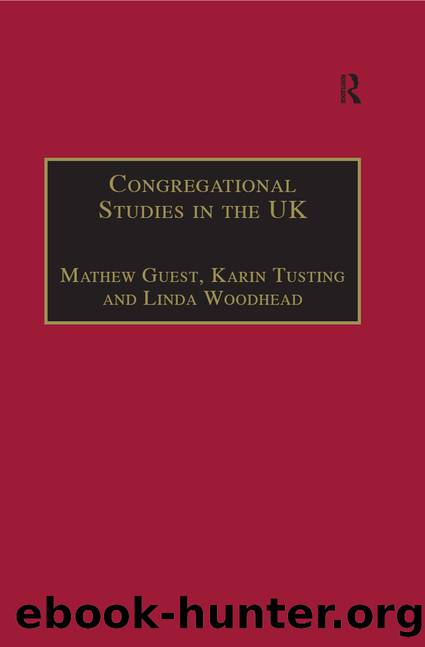Congregational Studies in the UK by unknow

Author:unknow
Language: eng
Format: epub
Publisher: Taylor & Francis Group
Chapter 8
Congregational Cultures and the Boundaries of Identity
Timothy Jenkins
I contend that congregational studies will most likely prove fruitful if the social anthropological method is included in the repertoire of methods adopted. I hope in this chapter to explain why this is so.
This chapter is necessarily condensed and somewhat abstract in its argument, for rather than presenting a case study it draws upon an already published ethnographic account of Kingswood in Bristol (âThe Kingswood Whit Walkâ in Jenkins, 1999, pp. 77â220), to which I must refer the interested reader to substantiate my claims. That study was based on intensive participant observation conducted over two-and-a-half years, focusing in particular upon the collection of more than sixty family histories. This material was supplemented by research in the local collections of the municipal libraries and the archives of local newspapers, and shaped by comparison with monographs from the community studies tradition and social history. The topics that emerged concern the importance of families in the occupation of a locality, the scansions of local history and how these are registered locally, and the forms taken by â and interactions between â local character and institutions. In a phrase, the account maps what I have termed âlocal particularityâ: the ways of life that create a sense of identity that relates to a particular place. This is a thoroughly ethnographic concern.
The argument here touches upon a number of connected questions that are allowed by such an account: the role that congregations play as local organizations; the relation of these congregations to more widely held social values; the ways that congregations include and exclude various persons, groups and issues; and how congregations deal with conflict. These topics are organized around a central question: who goes to church?
I advocate a social anthropological, rather than a sociological, approach; the chapter therefore begins with questions of method, for these will determine the kind of materials that count as evidence. It then turns to a consideration of indigenous categories, essentially those relating to a conception of personality, or identity. This leads in turn to an exploration of the sophisticated capacity of these classifications simultaneously to generate and to make sense of the events of everyday life. Only then is it fruitful to discuss the factors determining church attendance (which are of such interest to sociologists of religion). Finally, it is possible from this focus upon congregations to suggest how the discussion might contribute to other topics in the sociology of religion.
An Anthropological Approach
What is implied in adopting an anthropological approach when considering congregational behaviour? I suggest four criteria for consideration. The approach implies, first, instead of taking the congregation as a predefined isolate, looking at the human context in which the congregation is set, and seeing how the group under consideration manifests more widely held forms of understanding and behaviour. Second, rather than reaching too quickly for externally generated criteria, such as class or gender, or imagining the uncritical adoption of such external criteria by the subjects of the study (variants upon
Download
This site does not store any files on its server. We only index and link to content provided by other sites. Please contact the content providers to delete copyright contents if any and email us, we'll remove relevant links or contents immediately.
Warriors (9781101621189) by Young Tom(9648)
Red Rising by Pierce Brown(7351)
Dresden Files 01 - Storm Front by Jim Butcher(4546)
Enders Game 5 - Ender's Shadow by Orson Scott Card(4023)
Guilty Pleasures by Laurell K Hamilton(3603)
The Dresden Files Omnibus (1-15) by Jim Butcher(3543)
A Stormy Greek Marriage by Lynne Graham(2985)
The Heroin Diaries by Nikki Sixx(2943)
Drawing Cutting Edge Anatomy by Christopher Hart(2689)
The Boy, the Mole, the Fox and the Horse by Charlie Mackesy(2463)
Sharp Objects: A Novel by Gillian Flynn(2456)
Slugfest by Reed Tucker(2426)
Men at Arms by Terry Pratchett(2413)
The Complete Persepolis by Marjane Satrapi(2397)
The One Memory of Flora Banks by Emily Barr(2356)
The Twelve-Month Marriage Deal by Margaret Mayo(2317)
Altered Carbon (Takeshi Kovacs Novels) by Richard Morgan(2307)
The Replacement Wife by Caitlin Crews(2229)
Chris Owen - 911 by Chris Owen(2222)
